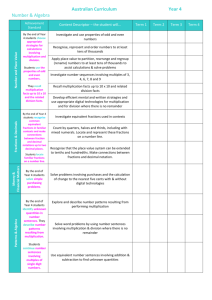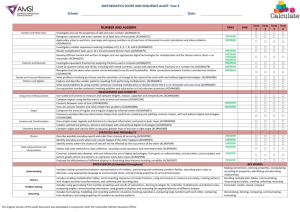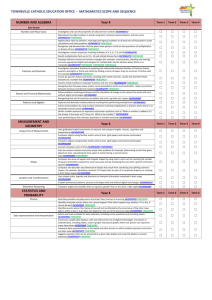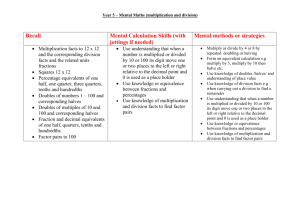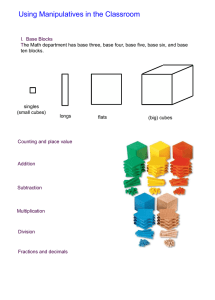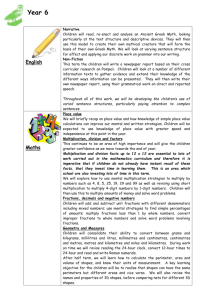Year 4 Math Rubric: Assessment Criteria & Levels
advertisement
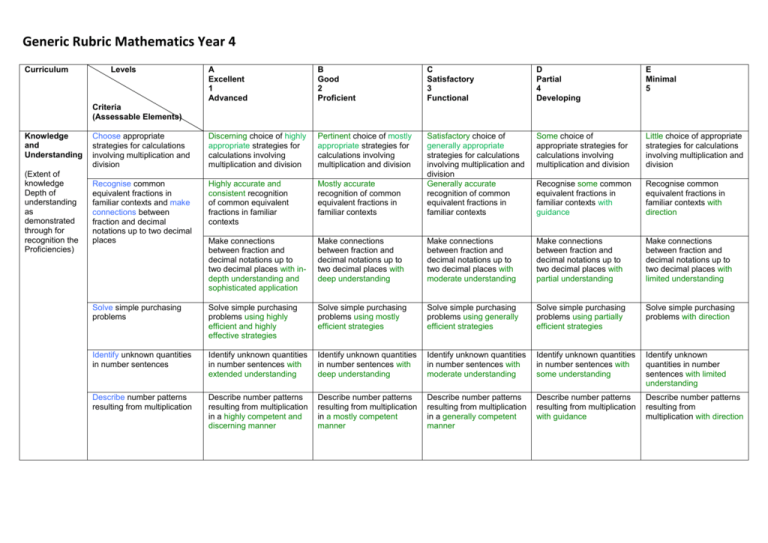
Generic Rubric Mathematics Year 4 Curriculum Levels A Excellent 1 Advanced B Good 2 Proficient C Satisfactory 3 Functional D Partial 4 Developing E Minimal 5 Choose appropriate strategies for calculations involving multiplication and division Discerning choice of highly appropriate strategies for calculations involving multiplication and division Pertinent choice of mostly appropriate strategies for calculations involving multiplication and division Some choice of appropriate strategies for calculations involving multiplication and division Little choice of appropriate strategies for calculations involving multiplication and division Recognise common equivalent fractions in familiar contexts and make connections between fraction and decimal notations up to two decimal places Highly accurate and consistent recognition of common equivalent fractions in familiar contexts Mostly accurate recognition of common equivalent fractions in familiar contexts Satisfactory choice of generally appropriate strategies for calculations involving multiplication and division Generally accurate recognition of common equivalent fractions in familiar contexts Recognise some common equivalent fractions in familiar contexts with guidance Recognise common equivalent fractions in familiar contexts with direction Make connections between fraction and decimal notations up to two decimal places with indepth understanding and sophisticated application Make connections between fraction and decimal notations up to two decimal places with deep understanding Make connections between fraction and decimal notations up to two decimal places with moderate understanding Make connections between fraction and decimal notations up to two decimal places with partial understanding Make connections between fraction and decimal notations up to two decimal places with limited understanding Solve simple purchasing problems Solve simple purchasing problems using highly efficient and highly effective strategies Solve simple purchasing problems using mostly efficient strategies Solve simple purchasing problems using generally efficient strategies Solve simple purchasing problems using partially efficient strategies Solve simple purchasing problems with direction Identify unknown quantities in number sentences Identify unknown quantities in number sentences with extended understanding Identify unknown quantities in number sentences with deep understanding Identify unknown quantities in number sentences with moderate understanding Identify unknown quantities in number sentences with some understanding Identify unknown quantities in number sentences with limited understanding Describe number patterns resulting from multiplication Describe number patterns resulting from multiplication in a highly competent and discerning manner Describe number patterns resulting from multiplication in a mostly competent manner Describe number patterns resulting from multiplication in a generally competent manner Describe number patterns resulting from multiplication with guidance Describe number patterns resulting from multiplication with direction Criteria (Assessable Elements) Knowledge and Understanding (Extent of knowledge Depth of understanding as demonstrated through for recognition the Proficiencies) Generic Rubric Mathematics Year 4 Sophistication of Skills (Sophistication of skills as demonstrated through the Proficiencies) Compare areas of regular and irregular shapes using informal units Highly effective and extensively reasoned comparison of areas of regular and irregular shapes using informal units Mostly effective and wellreasoned comparison of areas of regular and irregular shapes using informal units Moderately effective and generally reasoned comparison of areas of regular and irregular shapes using informal units Partially effective comparison of areas of regular and irregular shapes using informal units with some reasoning Limited comparison of areas of regular and irregular shapes using informal units with direction Solve problems involving time duration Solve problems involving time duration using highly efficient and highly effective strategies Solve problems involving time duration using mostly efficient strategies Solve problems involving time duration using generally efficient strategies Solve problems involving time duration using partially efficient strategies Solve problems involving time duration using limited strategies Interpret information contained in maps Highly logical and discerning interpretation of information contained in maps Mostly logical interpretation of information contained in map Generally logical interpretation of information contained in maps Partially logical interpretation of information contained in maps Interpret information contained in maps with direction Identify dependent and independent events Identify dependent and independent events with extended understanding Identify dependent and independent events with deep understanding Identify dependent and independent events with moderate understanding Identify dependent and independent events with guidance Identify dependent and independent events with direction Describe different methods for data collection and representation, and evaluate their effectiveness Describe different methods for data collection in a highly competent and discerning manner Describe different methods for data collection in a mostly competent manner Describe different methods for data collection in a generally competent manner Describe different methods for data collection in a partially competent manner Describe different methods for data collection with direction Critically evaluate their effectiveness Thoroughly evaluate their effectiveness Adequately evaluate their effectiveness Partially evaluate their effectiveness Limited evaluation of their effectiveness Use the properties of odd and even numbers Use the properties of odd and even numbers in a highly appropriate manner Use the properties of odd and even numbers in a mostly appropriate manner Highly accurate and consistent recall of multiplication facts to 10 x 10 and related division facts Mostly accurate recall of multiplication facts to 10 x 10 and related division facts Use the properties of odd and even numbers in a partially appropriate manner Partially accurate recall of multiplication facts to 10 x 10 and related division facts Use the properties of odd and even numbers with direction Recall multiplication facts to 10 x 10 and related division facts Use the properties of odd and even numbers in a generally appropriate manner Reasonably accurate recall of multiplication facts to 10 x 10 and related division facts Inaccurate recall of multiplication facts to 10 x 10 and related division facts Generic Rubric Mathematics Year 4 Locate familiar fractions on a number line Highly accurate location of familiar fractions on a number line Mostly accurate location of familiar fractions on a number line Generally accurate location of familiar fractions on a number line Partially accurate location of familiar fractions on a number line Locates familiar fractions on a number line with direction Continue number sequences involving multiples of single digit numbers Continue number sequences involving multiples of single digit numbers with extended understanding Continue number sequences involving multiples of single digit numbers with deep understanding Continue number sequences involving multiples of single digit numbers with moderate understanding Continue number sequences involving multiples of single digit numbers with partial understanding Continue number sequences involving multiples of single digit numbers with limited understanding Use scaled instruments to measure temperatures, lengths, shapes and objects Highly competent use of scaled instruments to measure temperatures, lengths, shapes and objects Mostly competent use of scaled instruments to measure temperatures, lengths, shapes and objects Generally competent use of scaled instruments to measure temperatures, lengths, shapes and objects Partially competent use of scaled instruments to measure temperatures, lengths, shapes and objects Use of scaled instruments to measure temperatures, lengths, shapes and objects with direction Convert between units of time Highly competent conversion between units of time Mostly competent conversion between units of time Generally competent conversion between units of time Partially competent conversion between units of time Conversion between units of time with direction Create symmetrical shapes and patterns Create symmetrical shapes and patterns in a highly competent manner Create symmetrical shapes and patterns in a mostly competent manner Create symmetrical shapes and patterns in a generally competent manner Create symmetrical shapes and patterns in a partially competent manner Beginning to create symmetrical shapes and patterns Classify angles in relation to a right angle Classify angles in relation to a right angle using highly justified reasoning Classify angles in relation to a right angle using welljustified reasoning Classify angles in relation to a right angle using adequately justified reasoning Classify angles in relation to a right angle using partially justified reasoning Beginning to classify angles in relation to a right angle List the probabilities of everyday events Extensive listing of the probabilities of everyday events Detailed listing of the probabilities of everyday events Satisfactory listing of the probabilities of everyday events Basic listing of the probabilities of everyday events Simple listing of the probabilities of everyday events Construct data displays from given or collected data Highly accurate construction of data displays from given or collected data Mostly accurate construction of data displays from given or collected data Generally accurate construction of data displays from given or collected data Partially accurate construction of data displays from given or collected data Construct data displays from given or collected data with direction Year 4 Achievement Standard By the end of Year 4, students choose appropriate strategies for calculations involving multiplication and division. They recognise common equivalent fractions in familiar contexts and make connections between fraction and decimal notations up to two decimal places. Generic Rubric Mathematics Year 4 Students solve simple purchasing problems. They identify unknown quantities in number sentences. They describe number patterns resulting from multiplication. Students compare areas of regular and irregular shapes using informal units. They solve problems involving time duration. They interpret information contained in maps. Students identify dependent and independent events. They describe different methods for data collection and representation, and evaluate their effectiveness. Students use the properties of odd and even numbers. They recall multiplication facts to 10 x 10 and related division facts. Students locate familiar fractions on a number line. They continue number sequences involving multiples of single digit numbers. Students use scaled instruments to measure temperatures, lengths, shapes and objects. They convert between units of time. Students create symmetrical shapes and patterns. They classify angles in relation to a right angle. Students list the probabilities of everyday events. They construct data displays from given or collected data. Last updated 21_9_2015
